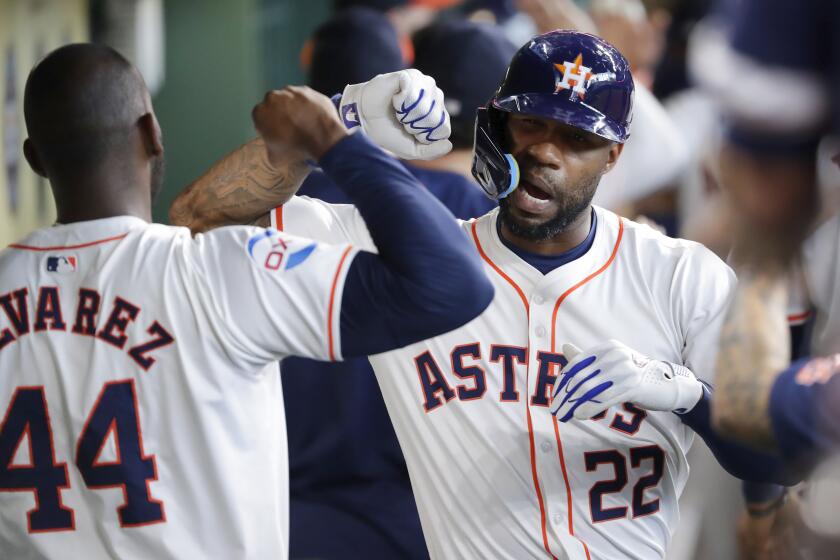Collectors Blame for Prices of Autographs
Now that the obnoxious pay-per-autograph season is behind us for another year, let’s divide the blame and put it where it belongs. If you’re among the thousands of collectors, you might not like the idea that the players are not at the top of the pecking order here.
Who is responsible for those outlandish prices charged for signatures at card shows around the country?
It will come as a disappointment to the purists in ga-ga land that “greedy,” “self-centered,” or “inconsiderate” athletes are often little more than innocent victims of the craze that has turned into a multimillion dollar business.
Sorry folks, but, contrary to popular opinion, the players are not the ones who establish going rates at these autograph extravaganzas. And if you run into one of your heroes in public, he’s not going to ask for $5 or $10 to sign a ball, card or picture. He might not sign (especially in the middle of the main course), but it won’t be because you don’t have the cash in your hand.
It’s still possible your idol is of the clay variety and might try to protect his market value. But even if he’s that sinister, you have to go step by step to the bottom line to find all the culprits.
Ultimately, you get to the consumer, and that’s where you stop. In this case, for the most part, that translates to collectors, the most serious of which become investors in a market that sometimes pays off better than blue-chip utilities.
Consider this one: About two months ago an individual spent $30,000 for 40,000 1989 cards bearing the picture and vital information of Milwaukee’s Gary Sheffield. Quick math reveals that works out to 75 cents apiece.
Because a player’s rookie card is considered the most desirable throughout his career (because it becomes increasingly more difficult to find), this speculator was gambling that the Brewers’ infielder would enhance the value by winning the American League Rookie of the Year award. He is considered the preseason favorite.
Since that time, half of the Sheffield cards reportedly have been sold at prices ranging from $1.35 to $2.50. That translates to a return of at least $27,000 on the investment -- with half of the inventory still outstanding.
The purchaser? A high school junior in Scarsdale, N.Y.
With staggering amounts of dollars to be made in the collector market, it was only a matter of time before others went after a piece of the action. Enter promoters, agents and, ultimately, the players themselves.
When the memorabilia-autograph shows -- like the ones held in Atlantic City and New Carrollton, Md., during the winter -- are put together, somebody takes a risk, everybody pays and the players walk away with hefty appearance fees.
But the accepted notion that players set a price for their autograph, sit at a table next to a cash register and put the autograph fee in their pocket is the biggest misconception of this fad-turned-scam, which may be on the brink of pricing itself out of business. Minnesota outfielder Kirby Puckett, for one, has said he will no longer do shows because of the negative reaction and the carnival-like “hustle” that is involved.
Autograph fees are determined by two things -- how “hot” the player is, and how much it costs (fee, plus travel expenses) to get him there.
Brooks Robinson, who has probably signed more autographs than any man alive, has profited from many appearances. But he says the market is close to being glutted.
“I do about 30 (shows) a year, but if I had the time I could probably do 200,” Robinson said. “It’s gotten to the point where there’s just too many of them now. I’ve been to shows where promoters have lost their shirt. A lot of time it (success of a show) depends on who is there, how hot he is, how much it costs to get him -- and how recently he may have done a show in the area.
“It’s really a no-win situation for the players, but they have no alternative other than to look at it as a business. That’s what it is -- and it’s a big business.
“I do my charity work here at home (Baltimore),” said Robinson, “but there’s no way I’m going to Cleveland, or Wheeling or even New Carrollton without getting paid.
“The people that go to those shows know what they’re getting into; nobody goes there expecting to get anything for free. They go to buy, sell and get autographs and 99 out of 100 go away feeling good.
“Every once in a while somebody will say this (paying for an autograph) is ridiculous, but when they go they know who’s going to be there. They have to buy a ticket to get in, usually $3 or $5, and that entitles them to one autograph. They pay for everything else.”
Believe it or not, one of the considerations before booking an athlete is how many times he can sign his name in an hour. “When they ask me that, I tell them, ‘More than anybody else -- and I can have a good time doing it,’ ” Robinson said. “That’s what some of these guys (players) don’t understand. The key is to enjoy yourself.”
That’s not always easy, according to Jay Finglass, owner of Jay’s Sports Connection in Towson, Md. Finglass has promoted a few small-scale shows locally and attended countless others.
“The promoters are not interested in you talking -- only how many autographs you sign in an hour,” Finglass said. “Time spent talking is money out of their pocket.”
Finglass agrees that the players get too much of the blame for the pay-per-autograph sessions, but he also points out that exorbitant appearance fees can drive up the price considerably. That’s where the agents come in because, in virtually every instance, bookings are made directly with the representative, who has a clue as to what his client is worth in the off-season.
“Some of these guys, before they reach the really big dollar state, can make more money in the off-season than they do by their salary,” Finglass said. “But it’s not fair to put all of the blame on the player. It’s the system.
“People willing to pay for autographs, promoters who can take a huge financial risk while looking for a profit, and excessive appearance fees all combine to drive the prices up.”
How much is a player’s appearance worth? As much as a promoter is willing to pay.
How much is an autograph worth? As much as a collector is willing to pay.
“A player like Brooks, for instance, his signature, especially around here, isn’t worth as much because he’s signed so many autographs over the years,” Finglass said. “The promoter of the show in New Carrollton lost a bundle. He paid Jose Canseco about $15,000, Pete Rose $12,000 and Fred Lynn $10,000. The price for Canseco’s autograph (one of the hottest on the market) was $14 and he signed about 500, which was a lot more than either Rose or Lynn.
“You can price yourself out of business, and it’s getting to the point where the risk is much greater than the reward.”
So much so, Finglass believes, that the number of shows is going to start to dwindle. When that happens, the prices also will drop because it is a case of supply and demand.
But players aren’t stupid. If somebody is going to make money from an autograph, the signee is going to get his share. They know there is a market to be nourished and, for that reason, some players aren’t as willing to sign a baseball card in a happenstance situation. There have always been those who don’t sign autographs on their time.
And there are other considerations besides the money. In Anaheim, Calif., for instance, there is one autograph hound who has been around the hotel lobby so long he could be showing up with his offspring any season. In New York, it is not uncommon for autograph seekers, young and old, to catch players as they board the team bus, then make it to Yankee Stadium in time to greet them when they arrive -- and then duplicate the procedure after the game.
“That’s where the player gets bad-rapped, when they try to get away from it in public -- but there are ways to handle that,” said Robinson. “Now, though, it really is a no-win situation for the players.”
It might improve, but it’s unrealistic to believe that collecting autographs will ever again be a means of fulfilling a youthful fantasy. Those days are gone.
You can blame the players if you want, but don’t forget the rest of the system that includes agents, promoters and -- most important of all -- the collectors.
More to Read
Are you a true-blue fan?
Get our Dodgers Dugout newsletter for insights, news and much more.
You may occasionally receive promotional content from the Los Angeles Times.








